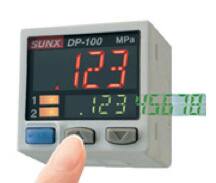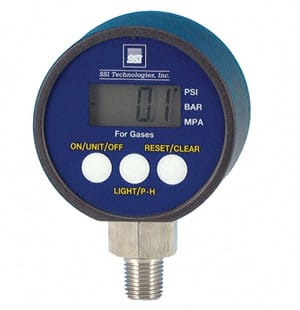Sensor Displays: Size, Shape and Color Matter
投稿人:电子产品
2013-11-07
Advances in display technology are making access to sensor measurement data easier and more accurate. With analog technology, dial gauges can trace their origin back more than 150 years, yielding to its digital counterpart in virtually all sensor domains, higher-accuracy measurement can now be made and effects such as temperature drift can now be calibrated, allowing the sensor to remain accurate over a wide range of operating conditions, resisting conditions like over-pressure spikes without sustaining damage to its sensing elements.
A new generation of sensor displays is using color and graphics that make the displays come alive to better alert operators to out-of-spec or dangerous process conditions. These devices also employ embedded intelligence that provides users with critical data in a more rapid, reliable, economical and efficient manner, and with a seamless interface to applications.
Multicolor LED displays
The Panasonic IAS Dual-Display Digital Pressure Sensor is a low-cost, three-color, dual-digital display that makes pressure sensors easier to use. Users can concurrently view real-time pressure readings and threshold value for quick changes during routine maintenance. The use of color in the display clearly shows abnormal readings even from a distance.
The easy-to-read display (Figure 1) offers a two-color setting, red and green, to indicate output state, and a third color, orange, to indicate menu settings. The 12-segment characters allow for both letters and numbers to be used for easy on-screen labeling of sensors in large arrays for immediate identification. The main display changes color in line with changes in the status of output ON/OFF operation, and also changes color while setting is in progress.

The sub display can be set to indicate any other desired values or letters apart from the threshold value. This eliminates the need for tasks such as affixing a label to the device to indicate the normal pressure value. Overall, the sensor status is easy to understand, minimizing operating errors.
The DP-100 series device offers two distinct pressure ranges, covering both high and low pressure. Both feature positive- and vacuum-pressure sensing. The series provides either dual discrete outputs or one discrete output and one analog output. The beauty of this system to the user is that since the current value and threshold values can be checked at the same time, switching screen modes is no longer necessary. ON/OFF operations are still carried out while the threshold values are being set, so setting to the same sensitivity as dial control-type sensors is possible.
Sensors can be connected to a master sensor individually while setting details for the master sensor is transmitted as data to the other sensors. This also prevents setting errors and reduces the number of changes in instruction manuals when equipment designs are changed.
It is not only differences in sensor size and shape that are making a difference in displays, digital pressure-gage technology has also advanced. The MediaGauge MGA-9V digital pressure gage by SSI Technologies (Figure 2) combines a 304 L stainless-steel input pressure port, a piezoresistive pressure-sensing element, signal-conditioning circuitry for temperature and calibration compensation, and a backlit LCD to display the pressure measured in PSI, BAR, or MPA units. The MediaGauge MGA-9V displays pressure readings after the ON/UNIT/OFF button is depressed, and pressure measurement readings are updated three times per second. There are three multi-functional buttons — ON/UNIT/OFF, LIGHT/P-H (Peak-Held), and RESET/CLEAR. The ON/UNIT/OFF button is used to display the pressure reading, switch between pressure units (PSI; BAR; and MPA), and to power down or power up the unit. The MediaGauge MGA-9V has a battery saver mode and will automatically shut itself off after 5 minutes. The LIGHT/P-H (Peak-Held) button is used to turn the LCD LIGHT on/off and to display the maximum peak pressure the unit has measured.

Typical applications include process control and compressors, and chemical compatibilities include noncorrosive gases and dry air. The compact, robust package measures 1.5 in. with a black ABS thermoplastic case.
What’s next?
UL considers an industrial control panel to be an assembly incorporating two or more pieces of industrial control equipment or related control circuit devices, provided with interconnecting wiring and terminals for connections in the field. As smaller form-factors, higher feature integration, less power consumption, and lower cost continue to drive sensor growth, how this data is conveyed to engineers and operators in cases where a full industrial information panel with complete text and graphics capability may not be needed, could yield something very different than we have seen in the past. From 3D images to portable flexible displays that at times can be bent, twisted, and deformed without damage, technology is racing forward with the promise of producing new means of receiving and conveying information that could result in wireless, wearable devices that fully display sensor data from a microcontroller and are part of a networked control system.
A hint at the importance of display technology to sensor-based developments comes with the news that among the 41 patents the US Patent Office recently granted to Apple, Inc., one in particular is an advanced sensor-based user interface. The technology will enable the user to interact with a display at a distance, and as the user moves away from the display itself, hand gestures will control the displays without the use of a remote-control device.
For more information on the parts discussed in this article, use the links provided to access product information pages on the DigiKey website.
免责声明:各个作者和/或论坛参与者在本网站发表的观点、看法和意见不代表 DigiKey 的观点、看法和意见,也不代表 DigiKey 官方政策。






